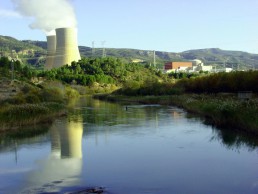- Home
- Environment
- The power station and water
The power station and water
All electrical power stations that utilize steam turbines, whether powered by fossil or nuclear fuels, need to draw from a water source as a coolant to produce steam condensation that, by expanding in the turbine, moves the generator and produces electrical energy.

In the specific case of Cofrentes nuclear power plant (Cofrentes NPP) a closed-circuit cooling system is utilized.
The average flow of the river Júcar in the area of the plant 45 m3/s, which has been granted use of a flow of 1.1 m3/s, with an annual limit on maximum total volume consumed of 20 Hm3/year.
From this flow, a part representing 0.75 m3/s, evaporates in the natural draft towers and the rest, 0.35 m3/s, returns to the river after a single discharge point and, after a series of prior chemical and radiochemical tests to determine radiological potability in accordance with the requirements set out by the Jucar River Hydrographic Confederation. See explanation , specified in the “Disposal Regulations for Cofrentes NPP”, and validated by the Nuclear Safety Council.
The properties of the water are monitored and controlled prior to its discharge into the river, with a view to maintaining the water quality within the limits established by the corresponding Administrative Authorisation. This process is made easier by the two discharge basins at a single emission point.
The cooling type used sensibly isolates the Plant from its surroundings, so that the thermal and biological effects on the river are virtually imperceptible.
